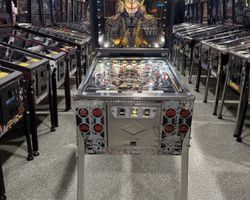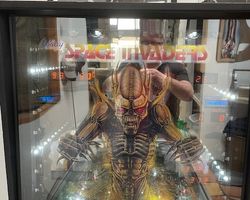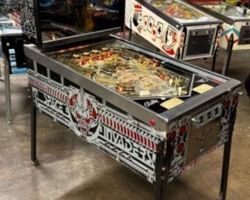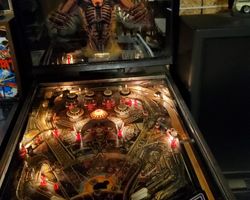Space Invaders
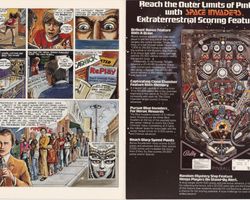
Average Prices: USD $400 to $2,100
Produced: April, 1980
Production Run: 11,400 units
Machine Type: Solid State Electronic
MPU: Bally MPU AS-2518-35
Players: 4
Design by: Jim Patla
Art by: Paul Faris
A distinct product of its era, the Space Invaders pinball machine from Bally Manufacturing Corporation emerged in April 1980, capturing the cultural zeitgeist of the burgeoning video game phenomenon. Bally, a dominant force in the arcade and pinball industries, capitalized on the widespread popularity of Taito's Space Invaders video game, which had taken arcades by storm in 1978. This pinball adaptation sought to translate the tension and atmosphere of digital alien combat into a physical playfield experience.
The design and production of Space Invaders involved a collaborative effort. Jim Patla was responsible for the game's design, charting the playfield layout and gameplay mechanics. Paul Faris, known for his imaginative and detailed artwork, crafted the machine's visual identity, including the distinctive backglass and playfield graphics. Rehman Merchant handled the software, programming the game's logic and scoring. With a substantial production run of 11,400 units, Space Invaders became a widely distributed title, reaching arcades and leisure establishments across the globe shortly after its April 1980 release. A notable aspect of its development was the legal challenge Bally faced regarding the backglass art. Fox Studios contended that the depiction of the alien creature on the backglass bore a strong resemblance to the xenomorph from their 1979 film "Alien," leading to a dispute that highlighted the intersections of intellectual property and design in the entertainment industry. Furthermore, elements of the game's sound design directly borrowed from the 1978 Space Invaders video game, creating an immediate sonic connection for players familiar with the arcade original. Internally, the machine utilized Bally's AS-2518-35 MPU, a solid-state electronic system common to many of their titles from this period, ensuring reliable and consistent performance.
Signature Features and Design
Space Invaders immediately distinguishes itself as a widebody pinball machine, offering an expansive playfield canvas that allowed for elaborate artwork and a more open layout than standard body machines. A defining characteristic, and perhaps its most visually arresting feature, is the infinity mirror backglass. Designed by Paul Faris, this element creates a profound sense of depth and cosmic void, housing the central alien creature that became the subject of legal scrutiny. The effect, achieved by strategically placed mirrors and lighting, provides a mesmerizing visual that amplifies the outer space theme and sets an immediate mood for play.
Beyond the aesthetics, the machine features a unique four-flipper configuration. While many pinball machines employ two or three flippers, Space Invaders presents two lower flippers and two additional, shorter flippers positioned higher on the playfield. This design choice, according to Jim Patla's original vision, intended all four flippers to be the longer variety, but the upper flippers were shortened during production to prevent interference with backhand shots from the lower flippers. This adaptation can still be observed by faint dimples on the playfield, marking the intended longer flipper positions. The presence of these four flippers significantly alters shot angles and ball control dynamics, providing players with more opportunities for strategic playfield manipulation. The overall aesthetic is one of intricate alien technology and cosmic warfare, permeated by a palette of dark blues, purples, and greens, punctuated by vibrant reds and oranges for targets and scoring elements.
Playfield and Mechanics
The widebody design of Space Invaders allows for a relatively open playfield, emphasizing precision shooting over a dense array of ramps and toys. At the top of the playfield, players encounter three pop bumpers, which provide kinetic energy and random scoring. These are complemented by four passive bumpers positioned strategically to redirect the ball. Below the pop bumpers, a series of six standup targets are scattered across the upper and mid-playfield, requiring accurate shots to activate. A three-bank of drop targets is centrally located, offering a clear objective for players to clear. A solitary drop target stands as a unique feature; successfully knocking it down diverts the ball into the plunger lane, accumulating bonus points while allowing for a skill shot to be taken, effectively a temporary ball save that rewards precise play.
A notable interactive element is the spinning target, which rewards continuous hits and contributes to scoring. The horseshoe lane, a curved path running along the upper playfield, demands precise shot execution to navigate fully, offering significant points upon completion. A captive ball sits in the mid-playfield, inviting repeated hits for score accumulation and satisfying visual feedback. Two slingshots flank the lower flippers, providing reactive deflections that can send the ball careening back into play or towards outlanes. The playfield artwork, intricate and thematic, features detailed renderings of alien spacecraft, cosmic debris, and futuristic landscapes. Lighting is used to highlight scoring opportunities and active elements, creating a sense of urgency and progression as players engage with the various objectives. The flow of the game often involves shooting for the drop targets to open up new pathways or aiming for the spinners and horseshoe for consistent scoring, while constantly managing the ball with the four flippers.
Gameplay Dynamics
Space Invaders employs a straightforward yet engaging scoring system, where the primary objective is to achieve the highest possible score, with a maximum displayable score of 999,950 points per player. The lowest scoring switches award 50 or 100 points, ensuring most final scores end in 00 or 50. However, the unique behavior of the passive bumpers, which award 50 points in 10-point increments over a few seconds, allows for scores not ending in 00 or 50 if the game tilts before the full points are registered.
The game's progression revolves around clearing targets and executing specific shots. The three-bank drop targets are a key objective, often leading to increased scoring potential or activating special features once cleared. The solitary drop target provides a strategic decision point: knocking it down allows the ball to return to the plunger lane, where all accumulated bonus points are added to the score, simultaneously granting a new plunge for a skill shot. This mechanic offers a unique risk-reward element, as players must decide when to capitalize on their bonus.
The game also features "hurry up" shots, where lit side arrows indicate timed scoring opportunities, requiring quick reflexes and accurate shooting reminiscent of the escalating tension in the Space Invaders video game. Mastering the horseshoe lane is crucial for high scores, as successfully navigating its path provides substantial points. For players aiming for the ultimate scores, repeatedly hitting the center roundabout—the area encompassing the drop targets and captive ball—is considered a primary strategy to push scores into the six and seven-figure range. The sounds in Space Invaders are integral to the gameplay experience, perfectly complementing the theme with authentic arcade-style sound effects, including the escalating "heartbeat" rhythm as the game progresses, directly emulating the original video game's soundscape and enhancing player immersion.
Reception and Legacy
The reception of Bally's Space Invaders pinball machine has been largely positive over time, often viewed through a lens of nostalgia for its unique aesthetic and thematic integration. Its artwork, particularly Paul Faris's backglass with its infinity mirror effect and "Alien"-inspired creature, is frequently lauded as one of the most compelling and visually striking designs in pinball history, often considered an art piece in itself. The game's sound package also garners praise for its accurate and atmospheric reproduction of the Space Invaders video game sounds, contributing significantly to the thematic cohesion. For many, the machine elicits fond memories of arcade play, reinforcing its status as a quintessential representation of late 1970s and early 1980s pinball.
Despite these strengths, Space Invaders has faced criticism regarding its gameplay. Some players find the widebody design, while visually impressive, contributes to a slower and more open playfield experience. This openness can lead to complaints of repetitive shots and a perceived lack of intricate flow compared to other machines of the era. The game's rules are sometimes described as shallow, with less emphasis on complex objectives or modes beyond simply accumulating points. The playfield layout can also be unforgiving, with a tendency for center drains if shots are not precise. Additionally, some examples of the machine show notable playfield wear, a common issue for games from this period.
Despite these criticisms, Space Invaders maintains a strong reputation within the pinball community. Its distinctive features, such as the four flippers and the groundbreaking infinity backglass, ensure its place in pinball history. It is recognized not only for its commercial success and production numbers but also for its bold artistic direction and its effective translation of a digital video game phenomenon into a physical pinball experience. The machine's visual impact and immersive sound design set a benchmark for thematic integration that influenced subsequent pinball titles. Its blend of straightforward gameplay with a captivating presentation ensures it remains a machine valued by pinball enthusiasts and collectors, a testament to its enduring appeal.
Sponsored Links
 Ebay Listings
Ebay Listings
 Auction Results
Auction Results
| Cost | Location | Date |
|---|---|---|
| USD $5,499 |  California, United States California, United States |
30 November, 2025 |
| USD $1,800 |  California, United States California, United States |
02 October, 2025 |
| USD $850 |  Illinois, United States Illinois, United States |
29 August, 2025 |
| USD $1,050 |  California, United States California, United States |
24 August, 2025 |
| USD $4,500 |  Virginia, United States Virginia, United States |
16 July, 2025 |
| USD $1,050 |  California, United States California, United States |
13 July, 2025 |
| USD $5,000 |  Florida, United States Florida, United States |
14 March, 2025 |
| USD $2,450 |  Pennsylvania, United States Pennsylvania, United States |
16 February, 2025 |
| GBP £2,050 |  Nottingham, United Kingdom Nottingham, United Kingdom |
07 February, 2025 |
| USD $4,995 |  Ohio, United States Ohio, United States |
21 November, 2024 |


Private Policy · Search Website · Contact Us
As an eBay Partner, we may earn a commission from qualifying purchases made through links on this site, at no additional cost to you.
All trademarks and copyrighted materials remain property of their respective owners. All other content copyright 2007 - 2026 Pinpedia.

